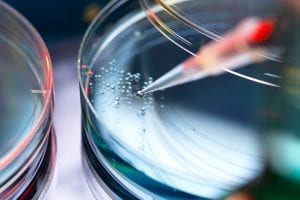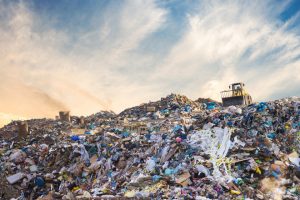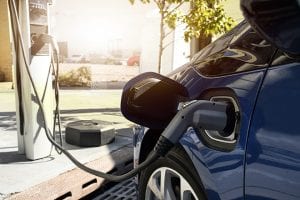A lot can happen in 30 years. Over the past three decades, we have seen explosive progress in science, technology and communications. In the same timeframe, the need for sustainable practices has become paramount. On the 30th anniversary since the origins of our Global Sustainable Equity team, we take a look at the developments that have shaped sustainable investing and the world we live in today.
Key takeaways:
- Resource use, waste production and environmental damage have been accelerated by population growth over the past three decades, worsened by consumer habits in the current linear economic model.
- Advances in technology – including the Internet, renewable power and batteries – have paved the way for efficient and sustainable practices which are renewable, electric and digital.
- We believe the next step in the planet’s sustainability journey is to decouple growth from the consumption of finite resources by operating through a circular economic model.
The 1987 paper Our Common Future, otherwise known as the Brundtland Report, provides the origins of sustainable investing. While ‘responsible investing’ traces its roots back much further, the concept of sustainable development was introduced by the report, commissioned by the United Nations. This defined ‘sustainability’ as “development that meets the needs for the present without compromising the ability for future generations to meet their own needs”. It was upon these principles that the Global Sustainable Equity team began investing four years later.
For the purposes of our look back, we group the drivers of development into three sections:
1. Science – transforming the outlook for life expectancy
Science and technology have changed significantly in 30 years. Well before the turn of the millennium, doctors and scientists had completed their first triple organ transplant (1986) and successfully cloned a sheep (1996). Since then, medicine has made significant advances that have a material impact on our lives. These have contributed to the sharp decline in HIV/AIDS related morbidity and mortality, a reduction in cardiovascular-related mortality, higher-than-ever success rates in surgery and, of course, vaccinations to address the COVID pandemic. Among developing countries, the introduction of immunisation, combined with other healthcare and development interventions – including access to water and sanitation, better hygiene and education – saw the annual number of deaths among children under the age of five fall by two million in the ten years to 2010.1
But while treatments for nongenetic ailments were improving, the understanding of genetic disease was not so advanced. In 2003, a long-awaited breakthrough in modern technology changed things with the successful sequencing of the human genome. This was the conclusion of a 13-year, US$2.7 billion project that transformed modern biology with ‘big’ science. Today, the human genome can be sequenced for less than US$1,000 and in around 24 hours.2 It is estimated that the use of medical genetic services could reduce mortality and disability in children under the age of five by up to 70%.3

As the standard of living improved across much of the world, so did global life expectancy. By 2011, people on average were expected to live to the age of 70 and today, the World Health Organization expects that this number has risen to 73.4 2011 was also the year that two thirds of the population had access to safe drinking water. Last year, that figure rose to three quarters.
2. Population growth – coming at a cost
Scientific advances contributed to the make-up of the global population, which has grown and urbanised rapidly. By 2011, the population reached seven billion – a billion increase on 12 years prior – and the human impact on the environment had become stark. Today, the global population stands at 7.8 billion, and the effects are ever more apparent. Resource use, waste production and environmental damage have been accelerated by population growth and worsened by consumer habits in a linear economic (take-make-dispose) model.

Plastic production has rocketed in the seven decades since its creation, reaching 381 million tonnes in 2015.5 Yet, 91% of it is not recycled and this is reflected in overflowing landfills and the deteriorating health of our oceans.6 11 million tonnes enter the oceans each year, and a study has shown that untreated drinking water contains 4.9 microplastics per litre.7 Intense farming and agriculture practices have led to a dramatic loss in the world’s forests, a loss that is particularly apparent in the Americas. At the same time, the incredible biodiversity of the planet is dwindling. The World Wildlife Fund reported that the global animal population declined by an average of 68% between 1970 and 2016.8

Meanwhile, atmospheric CO2, which contributes to the warming of the planet, has continued to climb. In May 2013, the Mauna Loa observatory in Hawaii recorded a daily mean CO2 concentration of 400 parts per million for the first time since measurement began in 1958.9 Today that number has risen to 412.97 parts per million. Global warming has caused the polar ice caps to melt at an alarming rate and arctic ice thickness has decreased by 40% since the late 1970’s.10 As a result, extreme weather events – wildfires, hurricanes and flooding – have become more prevalent across the globe.
The pace and intensity of human’s impact on the planet are clear. As the global population has grown, so too has consumption of the Earth’s finite natural resources. It is important to note that the utilisation of resources is not equal among individuals with millions still living below the poverty line, yet the cumulative effect is meaningful, and devastating. This poses the key question that the world is currently grappling with – are we prepared to accept the potentially uncomfortable trade off and cost of moving from an unsustainable linear economic model to a circular economy based around renewable, electric and digital drivers?
3. Innovation – potential solutions
In 1989, the World Wide Web was created. Little did English scientist and inventor Tim Berners-Lee know at the time, but the Web, or Internet, would change the social landscape forever. Free global communication would soon become prolific and a key driver of social and commercial evolution. Since the late ‘90s, individuals, businesses and governments have utilised the Internet to transform communication practices, and in some instances, remove communication barriers altogether.
The Internet has had a profound impact on education and wellbeing too. It has opened doors to a wealth of knowledge, varied forms of communication and educational resources to every corner of the world, helping to bridge the education gap between urban and rural populations. The Internet has also lifted many individuals out of poverty by enabling developing countries to gain access to the modern economy and catalyse job skill development. A study by Worldbank noted an improvement in welfare in households with access to mobile broadband.11
The technological architecture of today’s world is built around the Internet. Data can be stored, managed and accessed without having to own physical infrastructure such as data servers. This technology, known as ‘cloud computing’, enables efficient, on-demand and multi-platform remote access to a broad network. This technology can help to drive sustainability initiatives too. A study by Accenture highlighted that if all businesses migrate to the cloud, we could see a 59 million tonne reduction in CO2 emissions, the equivalent of taking 22 million cars off the road.12

The past 30 years has seen great strides in clean technology innovation too, with solar, wind, hydropower, geothermal and tidal energy making up the largest types of renewable energy. Between 1990 and 2018, total worldwide renewable energy supply grew at an average annual rate of 2%, compared to the 1.8% in total energy, with emerging markets accounting for the majority of growth in solar power.13, 14 2015 marked the first time that a country, Costa Rica, would run successfully on 100% renewable energy and in 2020, renewable sources outpaced fossil fuels in Europe’s energy generation. 15, 16
Batteries are another important component of sustainability and is an area that has seen a huge inflection in innovation over the past decade. To achieve higher penetration of renewable energy, it must be possible to capture, store and use energy when needed. Advances in battery technology have therefore been key to the movement away from fossil fuel dependence.
Lithium-ion batteries, rechargeable batteries found in portable electronics such as mobile phones and laptops, as well as hybrid and battery electric vehicles (EVs), have been game changers. The first purpose-built electric car was mass produced by General Motors in 1996 utilising less advanced battery technology. While General Motors EV1 venture did not end successfully, it paved the way for mass produced electric cars. Today’s EVs benefit from the long-range capability and lightweight design afforded by lithium-ion batteries. The past decade has seen lithium-ion battery production surge, leading to an 85% decline in price which has made EVs commercially viable. Last year alone, global EV sales grew by 41%.17, 18

Recently, the 2015 Paris Climate Accord has set challenging targets to limit global warming. The world’s most industrial economies have responded by establishing policies to achieve the goals of the Paris Agreement. The UK, US and EU have targeted carbon neutrality by 2050, while China aims to achieve the same goal by 2060. The International Energy Agency’s 2021 Roadmap to Net Zero outlines the scale, pace and political commitment required to achieve a net zero energy system which includes the need to invest at least US$4 trillion annually into clean energy technology by 2030. Today, countries have committed a huge amount of capital to create the conditions for a globally synchronised investment boom into clean technologies.
The path to a circular economy
As set out 34 years ago in the Brundtland Report, sustainable development is development which meets the needs of the present without compromising the ability for future generations to meet their own needs. Over the past three decades there has been huge progress in sustainability, yet significant challenges remain and, as things stand, we remain on a destructive path with an economic model that is still linear and fossil fuel driven.
On the positive side, science and technology have improved, and so has our understanding of what is needed to make the planet sustainable. We believe the next step in the planet’s sustainability journey is to decouple growth from the consumption of finite resources by operating through a circular economic model. In this model, the future will be shaped by renewable, electric and digital forces. But getting to this point will take concerted policy action at the highest level and a commitment in the face of difficult choices.
For 30 years, we have viewed the world through a lens of sustainability. We believe the world can make the necessary changes and that innovation holds the key to overcoming the obstacles ahead. By continuing to evolve and commit to the technologies already in place we believe it is possible, and essential, to switch to the circular economic model.
Footnotes
1World Health Organization, Global Vaccine Action Plan
2National Human Genome Research Institute, The Cost of Sequencing a Human Genome, December 2020
3J. Zarocostas, Serious birth defects kill at least three million children a year, February 2006
4Our World In Data, Life Expectancy, October 2019
5Our World in Data, Plastic Pollution, September 2018
6National Geographic Society, A Whopping 91 Percent of Plastic Isn’t Recycled, July 2019
7Marine Conservation Society, 2021
8World Wide Fund for Nature, September 2020
9National Oceanic and Atmospheric Administration, 2021
10Royal Society, Why is Arctic sea ice decreasing while Antarctic sea ice is not?, March 2020
11Worldbank, Expanding mobile broadband coverage is lifting millions out of poverty, December 2020
12Accenture, The green behind the cloud, September 2020
13International Energy Agency, Renewables Information, August 2021
14Carbon Brief, Analysis: How developing nations are driving record growth in solar power, November 2017
15Time, How Costa Rica Went 75 Days Using Only Clean Electricity, April 2015
16Bloomberg, Renewables Beat Fossil Fuels in EU for First Time Last Year, January 2021
17CNBC, The battery decade: How energy storage could revolutionize industries in the next 10 years, December 2019
18International Energy Agency, Global electric car sales set for further strong growth after 40% rise in 2020, April 2021

